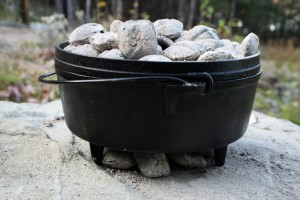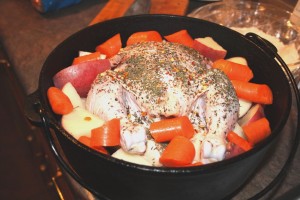Sandra is cooking again. This time she tempts tastebuds with the wonders of cooking outdoors in a Dutch oven.
I’m in love again. Totally smitten. This tim e with a Dutch oven. Especially cooking outside with one. Have you ever tried this? Can you explain just why or how come the food tastes different when it’s cooked out doors in a Dutch oven? I’ve been trying to figure that out for a couple of years now. But I digress.
e with a Dutch oven. Especially cooking outside with one. Have you ever tried this? Can you explain just why or how come the food tastes different when it’s cooked out doors in a Dutch oven? I’ve been trying to figure that out for a couple of years now. But I digress.
When I tried searching for the history of Dutch ovens I discovered that many cultures use them. In Japan they are called tetsunabe; in Africa, potjie; in Australia, bedourie. I also learned that by the 1700s the Dutch had developed a way of producing cast metal cooking vessels that were quite smooth compared to other pots (due mainly to using dry sand to make their molds.)
Abraham Darby, an Englishman, travelled to the Netherlands and studied how this was done. He then patented a similar procedure and produced cast iron pots which he sold in Britain and the Americas.
The term “Dutch oven” may have come from his research into Dutch foundries. Or, as some believe, the term may have come from Dutch traders who peddled these pots from their wagons as they travelled from one community to another. Regardless, the term “Dutch oven” as we know it has been around for at least 300 years, and its actual use around the world—albeit in pots with different names—for much longer. It’s been said that the Dutch oven was to a pioneer’s chuck wagon as the microwave is to a modern kitchen today.
How to Cook Outdoor s with a Dutch Oven
s with a Dutch Oven
The key is to have a heat source (wood or coals) under the Dutch oven and on top of the cover—especially if you are baking. A general rule of thumb is to have about one-third below and two-thirds on top. For example: 10 coals under the Dutch oven and 20 over the cover. This way, you don’t need a big campfire to prepare a meal.
Here’s an easy chicken dish (see photos above): Place a little cooking oil in the Dutch oven, add a small whole chicken, sprinkle salt, pepper and handful of herbs like summer savory or oregano. Drop in some small potatoes, hunks of carrots and a chopped onion. Add a cup or so of water, put on the lid and cook. An hour later you’ll have a meal fit for Pharaohs.
Here area a few more recipes to wow your family and friends.
(Uh-oh. What if you don’t have a Dutch oven? You can do all this in a pot on the top of your stove at home. Just don’t tell.)
Potato Celery Soup
3 tbsp butter
4 stalks celery, diced
1 onion, diced
6 potatoes, diced
4 C water
1 tsp each salt and pepper
2 tbsp parsley
5-6 C milk
Melt butter and brown celery and onions. Add everything else except milk. Cover and cook for 30-45 minutes. Remove cover, add milk. Cover again for 5 minutes.
Note: You can easily add other ingredients to this soup such as peas, carrots and cooked ham.
Dessert Dumplings
1 C flour
2 teaspoons baking powder
¼ teaspoon salt
2 tablespoons shortening
½ C milk
2 ¼ C pure maple syrup
1 C sugar
1 C water
Mix first four ingredients together. Add flour. Dissolve sugar in water in your Dutch oven. Add maple syrup, cover and bring to a boil. Make balls the size of golf balls out of the flour mixture. Drop into the hot maple syrup mixture. Cover. Cook for 10 minutes.
Photo Credits
All photos Sandra Phinney



[…] This post was mentioned on Twitter by Gil Namur, Dan L Hays, Life As A Human, Jazz Dog, Life As A Human and others. Life As A Human said: New Article, Going Dutch – http://tinyurl.com/28eltvq […]